find out, how to remove the old tile in the kitchen and attach a new
The best material for the flooring and walls of the kitchen - tiles. Tiles for the kitchen meets all the requirements put up, he is not only resistant to external influences, but also able to decorate the room and hide flaws.

properties of tile, as a finishing material
choosing tile, guided by the class. Do not buy a tile on the floor below the third class, on the walls - below the second. Takes into account such parameters, as heat (not lower than 125 ° C), porosity, resistance to household chemicals (class is not lower than A), resistance to mechanical stress, shock and scratches.
Advantages of tile:
- Pottery - a natural material. It is safe for humans and the environment, because it consists of clay with impurities.
- Thanks to the natural composition of the tiles is not toxic, It does not cause allergy and is suitable for use in the kitchen, in the bathroom.
- tile hygienic, it does not breed bacteria and fungi. Therefore, it is used for finishing of medical institutions and laboratories.
- Tile is not afraid of water, and it is an important feature for the kitchen.
- Thanks to the layer of glaze, coating does not adhere to dirt and dust, easy to clean, possible use of detergents and disinfectants.
- Correctly matched tiles will not crack, It does not lose color and will last decades.
- Pottery is not abraded, not afraid of heels or moving furniture.
- fireproof tiles, non-flammable, and even stop the fire. It is placed in the oven, fireplaces, plates.
- Ceramics adorn any kitchen. On the market there are a large number of tiles of different formats, colors, textures.
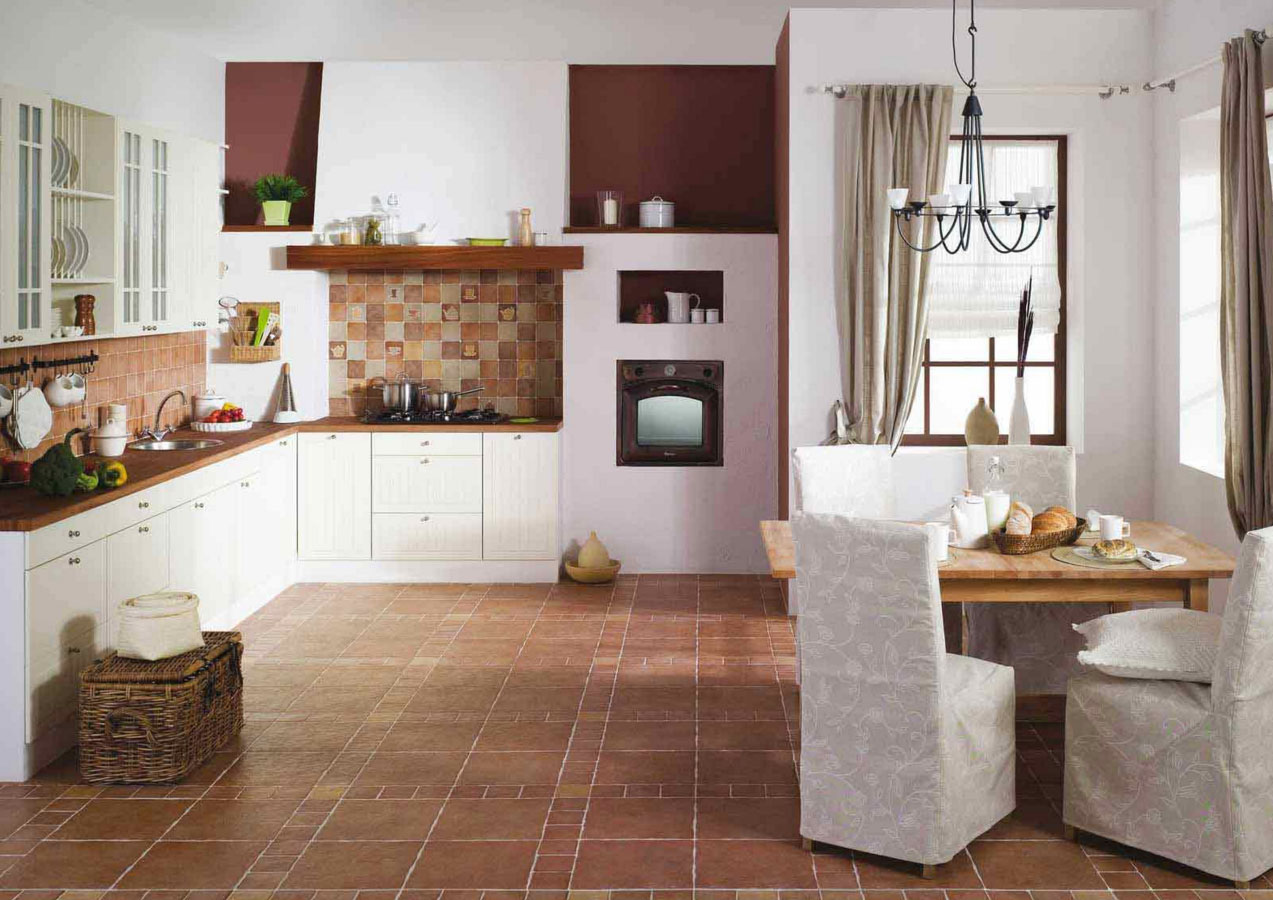
wall tiles
Wall tiles are not required the increased strength, because its purpose - the protection from moisture, heat, household chemicals. The design in this area is of great importance. Original tile working apron will become the central focus in the interior.
To ceramics harmoniously fit into the interior, you need to follow the recommendations:
- Large squares for spacious kitchens, in a small room, they "eat" space.
- Vertical and horizontal friezes ornamental uses, to arrange the spatial accents.
- Actual use of several types of tiles of different colors, size, textures.
- Tile with a pattern or decorative panels can be a major emphasis in the interior.
Species diversity tiles is not only a wide choice of colors, paintings and ornaments. Manufacturers produce ceramics, simulating the texture of natural materials.
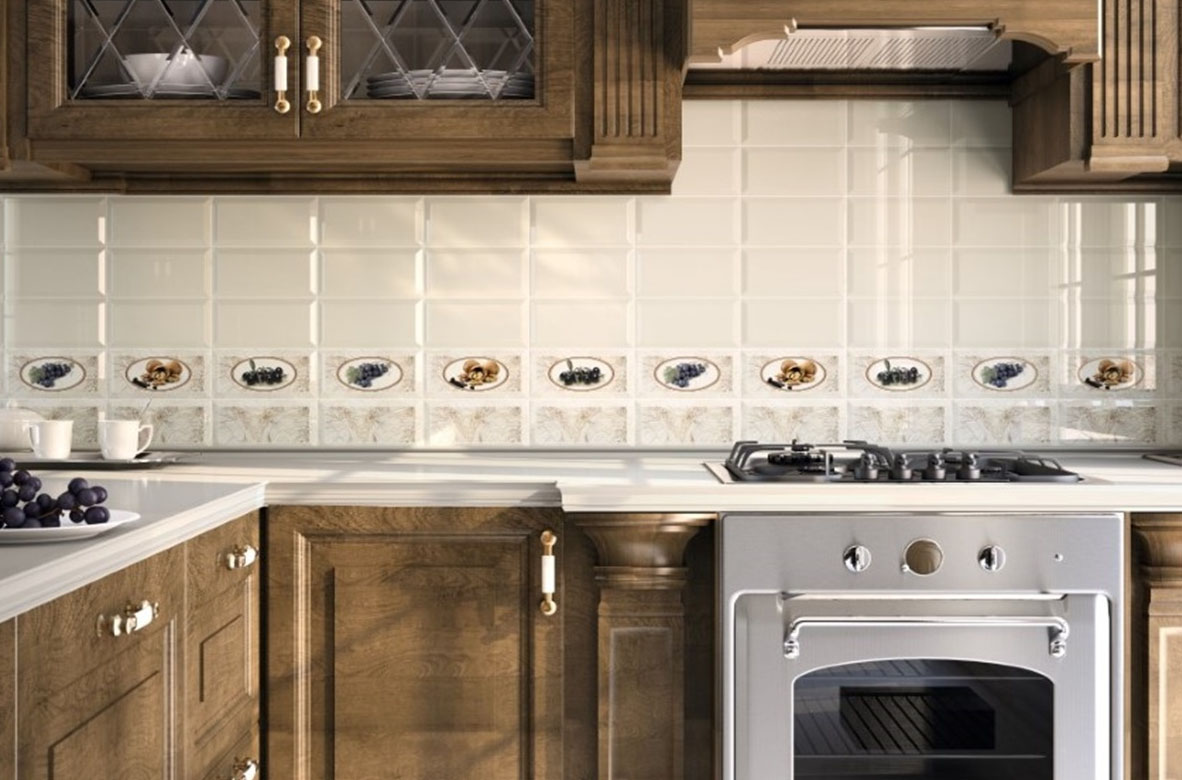
imitation brick
Tile under a brick is always relevant. It is available in different colors, formats, It is glazed and frosted. bricks tiles fits well in vintage interior, style kitchen: urban, Mediterranean, Provence, country, loft. Note, textured apron that requires careful maintenance. It is more difficult to clean from grease and grime.
imitation wood
Tile Wood is an excellent choice for lovers of eco-decoration. Such products are in demand and are produced by many manufacturers. They imitate precious woods. This tile replaces the wooden floors and parquet. tile, simulating the wood panels, veneer wall. Unlike natural wood, ceramics:
- hygienic;
- not afraid of water;
- resistant to high temperatures;
- does not burn;
- It is not damaged by harsh chemicals;
- It does not absorb odors.
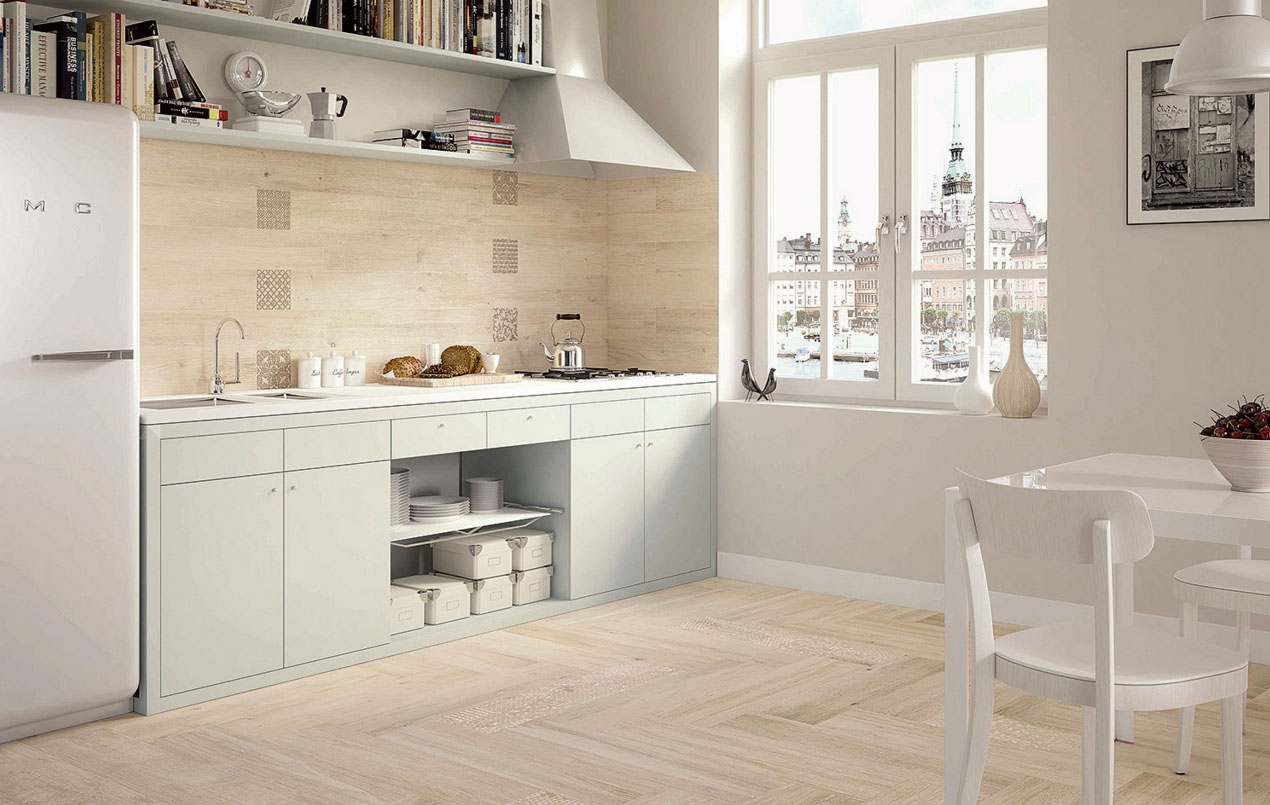
imitation stone
Floor tiles under a rock for the stylized vintage interior. The walls are faced with and imitations of bas-reliefs. With the help of tile creates a rough medieval or ethnic style. Noble looks coating under a rock in the style of classic kitchens, traditional, country. It is combined with massive wooden furniture, natural fabrics, forged elements and other textured materials. Tile imitates marble, granite, slate and other stone rocks.
elements, repeating the old masonry with scuffed, chipped and cracks, fit to recreate the atmosphere of an old house in Mediterranean style.
imitation leather
Unusual and exotic option - tiles, imitating the skin of rare animals. She looks incredibly luxurious. Tiles under the skin of a zebra, snake or crocodile complement the interior African style. A more modest option - a combination of tiles under the skin of several contrasting colors.
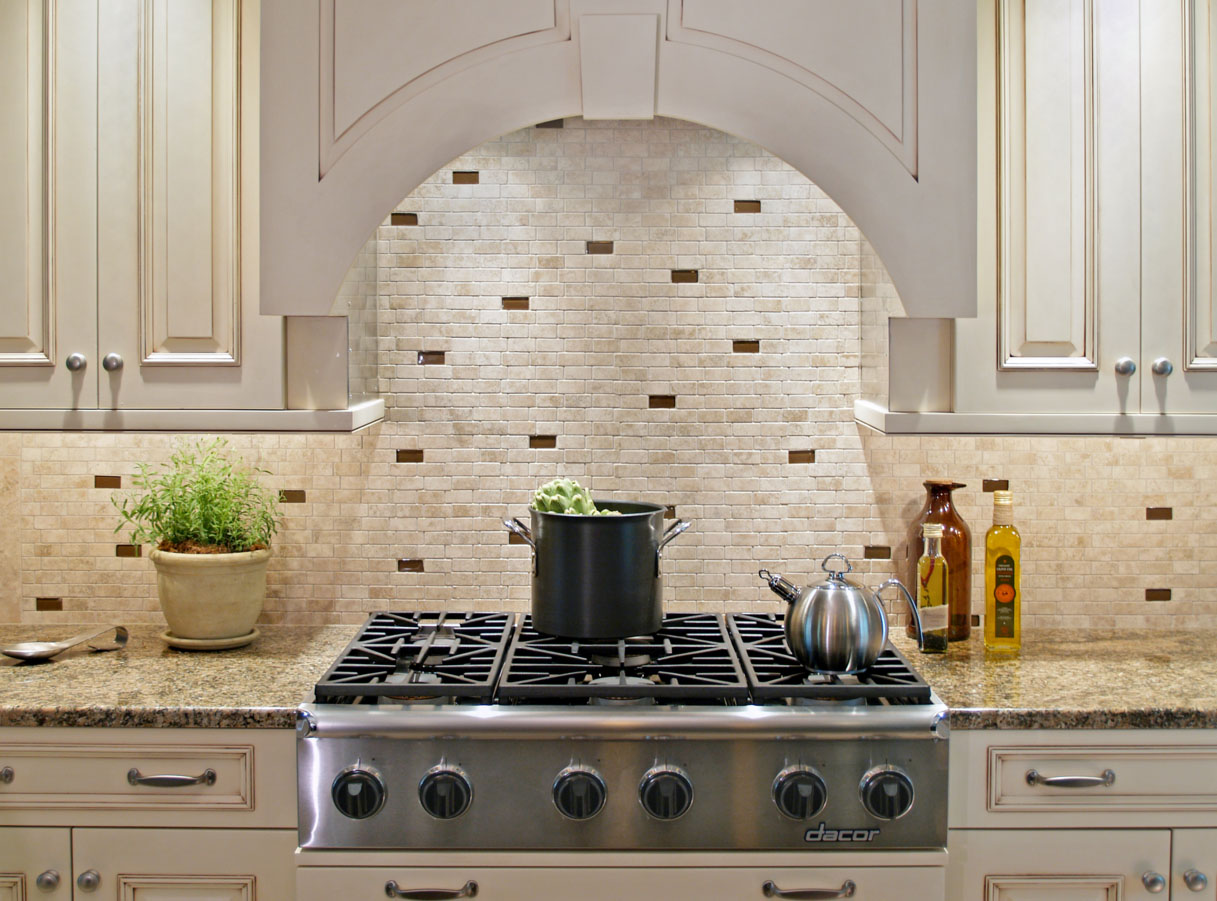
Imitation metallized surface
there is an opinion, that imitates metal tiles are not suitable for the kitchen, It makes it uncomfortable. However, such a surface makes the interior a touch of modernity and complement the interior in the style minimalism and high-tech. Apron natural metal impractical, it is too visible splashes and fingerprints. On a tile dirt is less visible, and it is easier to clean.
Stickers on tiles
The interior of the tiles on the kitchen performs, including, and a decorative role. What to do, if the coating is still in decent condition, but you want something new? In this situation, useful vinyl stickers on the tiles. They are also used, to cover minor defects, scratch.
There are stickers with funny drawings, designed to lift the spirits. for example, cartoon cups and teapots. Subject cookware is very popular, there are also realistic images.
Another common theme - fruits and vegetables. Pictures are both sketchy, bright, and reminiscent of the classic still lifes. Decorate the kitchen can and inscriptions. You can easily print a favorite recipe.
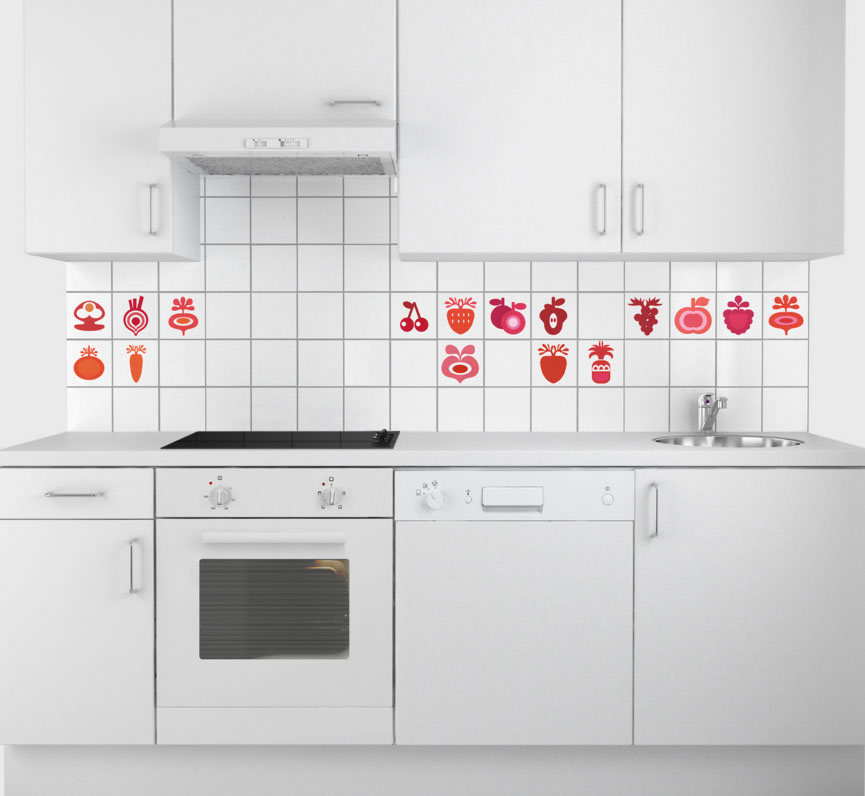
Floor tiles
Tiles on the floor for the kitchen - a traditional choice of many housewives. But such an approach creates controversy. Let us compare the pros and cons of the use of ceramics for decoration of the kitchen floor.
pros:
- Tiles for the kitchen on the floor looks solid.
- The spilled water on the floor will not bring any harm to the coating.
- Not afraid of the ceramic hot oil splashes, chemicals.
- Gender does not change color when exposed to sunlight.
- The flooring in the kitchen is not deformed.
- Wash such floor easily.
Minuses:
- Tiles on the floor cold. This problem is solved by installing underfloor heating or buying slippers. Some housewives note, that in a warm house to go barefoot on ceramics comfortable.
- Nothing can be dropping. Glassware, upavshaya sex, necessarily break. But heavy kettle or a hammer smash the tile itself. In that case, should keep the house parts, to immediately replace the damaged section. note, that the laminate flooring or too sensitive to shock.
- slippery tiles. Properly chosen ceramics with friction class of 0,75 does not turn into a skating rink, even if water is spilled.
Floor tiles should be in harmony not only with kitchen unit, but with walls finished. The task is greatly simplified, if the walls are also covered with tiles. Manufacturers offer easily compatible options.
Laying tiles on the floor
Many people prefer to lay tile floors yourself. This process is able to perform a man, having experience in building and skills with tools. Often young families are strapped for cash, and the work is performed without the aid of professionals.
Application Method
Let's see, how to put the tile on the floor. Laying tiles on the floor with their hands begins with planning. Driving tile - a factor, from which depends the appearance of the kitchen. Common ways of laying:
- Base. Fastest and cheapest way. Tile is laid in rows parallel to the walls, without changes. It is important to keep straight rows and equal spacing between the tiles.
- Stacking "brick" tile - is laying parallel to the wall with a shift. This clutch looks, as masonry. With this method is not recommended to use tiles of different textures or colors, It seems uneven floor.
- Diagonal tiling begins from the corner. This option visually expands the room, but it is more expensive, because it will have greater crop.
- "Firtree" rectangular elements laid out and recalls parquet.
- "Labyrinth" - a combination of a small square tiles with contrasting rectangular.
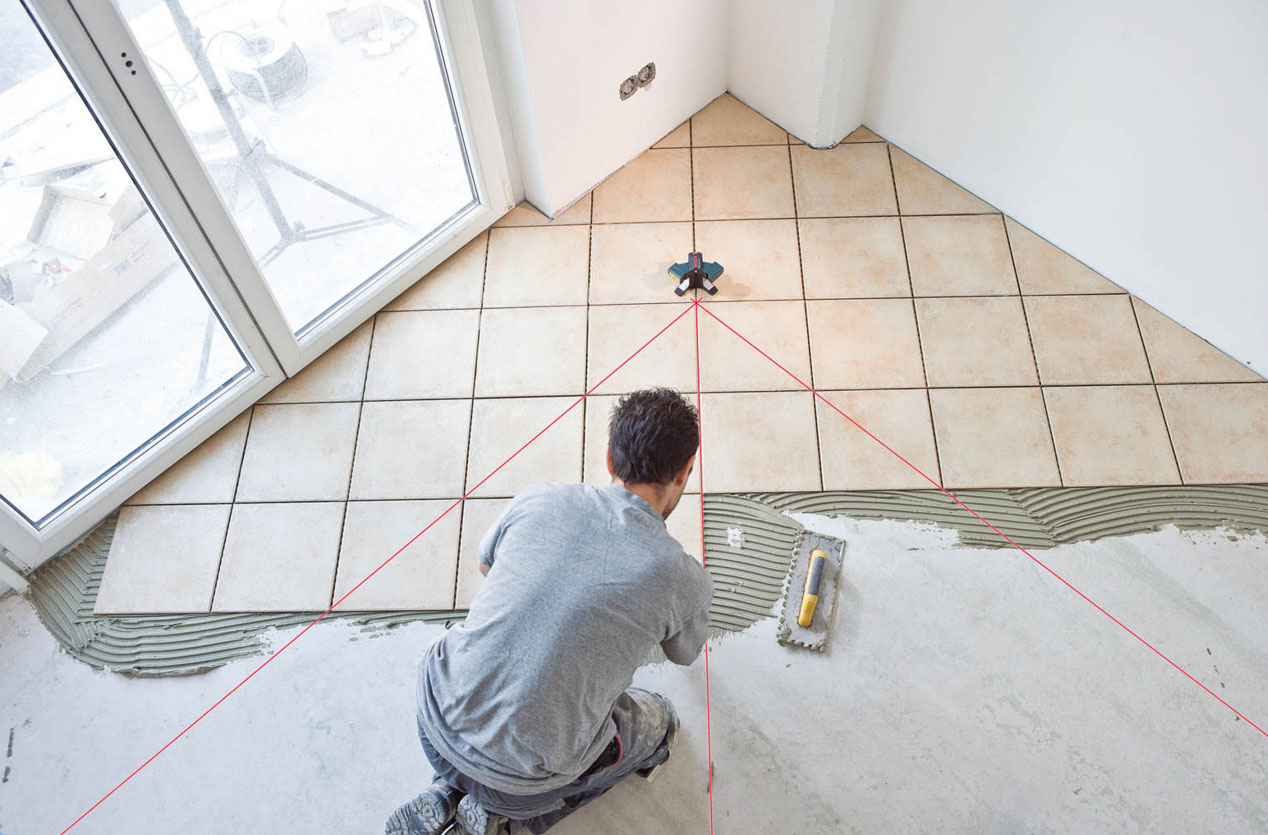
Preparation for work
Laying tile begins with preparation for work. Possible options for laying new tiles on the old, or even on a wooden floor chipboard. But if you do the repair quality, you need to remove the old paint and form tie. But removing the old tiles?
many think, it's impossible, and remove the old tiles can only professionals with the power. This is not true. If the tiles laid on cement, then save it unlikely. But the laid on glue tiles to remove and leave a whole lot easier.
A simple way to remove the old tiles - with a sharp ax or hammer and chisel. If the tile is held loosely, it is possible to gentle removal by means of special steel hooks. Then wet residues of the solution and remove it with a spatula. Now remove the plinth, thresholds, Clean and prime with a floor.
Prepare the tile adhesive and let it stand for minutes 15, that all components of the solution.
laying
Technology laying tile on the floor is simple, but the following algorithm and do everything carefully.
- Make the layout and prepare for the first of several stops, consisting of whole tiles.
- The first element is placed on the far corner of the door at a distance, to plate the threshold do not require pruning.
- Apply a layer of adhesive on the floor portion notched trowel.
- On tile apply a thin layer of glue, invest ego in half.
- adjust the width of the seams crosses.
- Check the evenness of the laid tiles, trimming the protruding corners with a rubber mallet.
- Remove the crosses before curing glue.
- After putting some solid tiles, stacked cut parts.
- The last stage - the grout.
How to saw tile floor? You will need a special tool - Tile or machine with the cutting circle. Tile is fixed in Tile, Line cutting wire wheels, on which tile breaks.
Carefully and wisely choose a tile, neatly, observing the rules, invest, and it will delight you for years to come.
